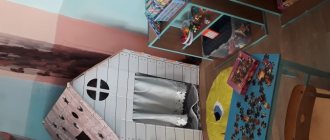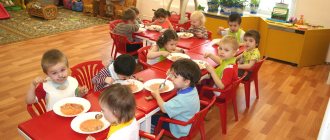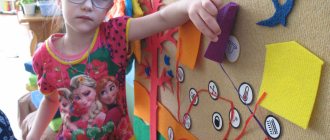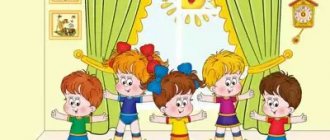In your opinion, at what age should children be introduced to the theory of solving inventive problems? While you are thinking, we will answer: from kindergarten. No, no, we are not talking about forcing preschoolers to take integrals or design 3D graphics. The point is to teach children to think creatively and find ways to solve problems that arise before them.
Agree, even the most loving and caring parents cannot give their children ready-made templates for solutions for all occasions. And not even because it is physically impossible, but because it is not necessary. A much more reasonable step would be to instill in children an algorithm for solving emerging problems and teach children to use it.
Our program “TRIZ in practice: a creative approach at work and in life” will help you with this. And, of course, our article about TRIZ methods for preschoolers, where we will look at the basics of this creative approach for the little ones who have already reached kindergarten, but who are too early for school. This is the most important stage, because it is during this period of life that children lay the foundations of thinking and the foundations for their future success in school and life.
TRIZ - what is this method and where is it used
TRIZ is a set of methods for solving problems and improving systems. With its help, you can increase efficiency and improve your ability to solve complex problems, while using a creative approach, developing imagination and flexible thinking. Some experts consider this theory to be the most effective for developing creative skills because it is not judgment-based and does not provide a single correct answer.
The theory is applied when inventive problems arise on a person’s path. These may be problems that cannot be solved in obvious or familiar ways. That is, you need to invent something that will help you win without any losses.
Benefits of technology
Many people have studied this technique and actively used it in their practice. As a result, they established the following advantages of its use:
- identifying the essence of the problem through a different approach;
- departure from traditional ways of resolving problems;
- increasing the efficiency of creative activity;
- obtaining knowledge and correct systematization of this knowledge in the process of searching for information on choosing a problem and direction of solution;
- getting an impetus for inventive activity;
- correct determination of the main search directions, taking into account those nuances that are usually ignored;
- development of logical, illogical and systematic thinking;
- development of a new look at some things and phenomena;
- broadening one's horizons;
- reducing the time spent searching for a solution.
Why is the TRIZ methodology needed in kindergarten?
We all come from childhood, and the foundations of a person’s future life are laid precisely in preschool age. At this time, the little person learns to walk and talk, read and write, listen and understand, communicate and express emotions, and, of course, think.
Today, creative thinking is needed in almost any field of activity: law and software development, medicine and the construction of country cottages, pedagogy and even the installation of telecommunication networks, because communication means penetrate where nothing is suitable for their use.
How work with children in kindergarten is structured largely determines how creative thinking will be developed in children. And, therefore, how well they will study, how well they will choose a profession and how well they will be able to fit into the modern world. The objectives of the TRIZ methodology are precisely to teach a creative approach, and therefore are ideally suited for working with preschoolers.
Children are not yet constrained by perception patterns, they are inquisitive and spontaneous, they are just learning about this life. Therefore, nothing prevents them from imagining their imaginary world and deciding for themselves how they want to see it. Ideally, children should not only not be disturbed, but also indulge in every possible way their desire for creativity and learning everything new. The introduction of the TRIZ methodology in a preschool educational institution (preschool educational institution) contributes to the creative process to the fullest.
Let us note that creativity is not some separate process isolated from everything else. Creativity is directly related to the development of analytical thinking, observation, attentiveness, imagination, speech, and the acquisition of new sensorimotor skills. As a result, the ability to think creatively contributes to the formation of a multifaceted personality with a broad outlook and the ability to practically solve emerging problems.
Objectives of the TRIZ methodology:
- Development of creative perception and thinking.
- Development of the qualities of a creative personality.
- Formation of vocabulary.
- Development of coherent speech and the ability to express thoughts.
- Pronunciation correction.
- Formation of perception of numbers and mathematical concepts.
- Teaching constructive activities.
- Instilling socialization, interaction and teamwork skills.
Thus, the TRIZ methodology contributes not only to creativity itself. The TRIZ technique is no less useful in developing coherent speech, replenishing vocabulary, acquiring skills in operating numbers and mathematical concepts, and much more. It is probably easier to find what is not included in the tasks of the TRIZ methodology.
Therefore, the TRIZ methodology in kindergarten is needed, on the one hand, to develop flexibility and systematic thinking, and on the other hand, to stimulate search activity and the ability to find answers to non-standard questions. Using the TRIZ methodology, you can significantly activate a child’s creative potential, his mental activity and imagination, and raise a child into a real inventor and generator of new ideas.
And one more important point. A kindergarten, a group in a kindergarten, is a small group, but a team. And sometimes it’s not a small, but a fairly large children’s group. Group classes using the TRIZ method teach children cooperation, interaction, the ability to help a friend and find a way out of a difficult situation, as well as rejoice at their own and others’ successes when the problem is successfully solved.
The results will not take long to arrive. Parents and educators will soon see that the child’s drawings have become more diverse, artistic subjects are more complex, speech is more literate, and now the child assembles structures from Lego not only from the proposed pictures, but also by inventing his own figures.
In general, TRIZ is a useful technique for children in all respects. All that remains is to figure out how to apply such a complex technique as TRIZ for such young children as preschoolers.
Historical reference
The TRIZ method was invented by the Soviet engineer and writer Genrikh Saulovich Altshuller. He is also the author of another theory - the development of a creative personality (TRTL).
In 1946, Altshuller studied the techniques that inventors often use to solve problems. As a result of the study, he identified 40 such techniques and called their totality the theory of solving inventive problems. At the same time, the author concluded that the most effective result is achieved through the use of existing resources.
In the 1980s, the theory was used to teach in Soviet schools and improve efficiency in factories. Today this technology is recognized throughout the world. Leading companies such as Intel, HP, Boeing, Ford, Toyota, Kodak and many others are implementing TRIZ practices in their activities. In addition, world conferences on this topic are held annually, and international, Asian and European TRIZ associations have been created. And in 1998, the Altshuller Institute even opened in the USA to train engineers and managers in this technique.
What is the TRIZ system and how does it teach children to be resourceful and think independently?
The word “savvy” has been undeservedly forgotten by us, although we all use it (and it would be better even more often). And even critical thinking cannot become a full replacement for it. The ability to grasp the essence of a problem and find non-standard solutions for it is the “savvy” that the TRIZ system, or the theory of solving inventive problems, teaches.
Useful Mela newsletter twice a week: Tuesday and Friday
SUBSCRIBE
How TRIZ pedagogy appeared
The system appeared in the middle of the 20th century, and at first it was not even related to pedagogy. In 1946, Soviet engineer, scientist and science fiction writer Genrikh Altshuller began studying the techniques most often used by inventors. There were about forty such techniques, and all of them, together with the algorithm for solving inventive problems (ARIZ), formed the basis of TRIZ.
During this time, it acquired new algorithms, and by the early 80s they began to use it as the basis for teaching methods in experimental classes and schools. The goal of TRIZ pedagogy is the development of flexible thinking and imagination, the ability to solve complex problems in elegant and effective ways.
Altshuller found out that any technical problem leads to a situation in which every inventor finds himself: a moment when a solution has not yet been found, but there are many options around. The trial and error method is an unreliable and energy-intensive method, which does not guarantee excellent results. The scientist came to the conclusion that the most effective solution is achieved using existing resources, that is, in the process of solving a problem, you need to cut off everything unnecessary, then the answer will become obvious.
Genrikh Saulovich Altshuller, author of the Theory of Inventive Problem Solving (TRIZ)
TRIZ pedagogy has little in common with classical and developmental pedagogy. Firstly, there are no grades or a single correct answer: children must reason, reflect, look for contradictions and unusual signs in the conditions of the task. Secondly, in order to begin the basics of TRIZ pedagogy, a child does not necessarily have to be able to read, write and count: you can work with a child from the moment he becomes able to distinguish a game from reality, that is, from about 2. 5-3 years.
TRIZ methods
In the process of solving TRIZ problems, several approaches are used at once:
- brainstorming method,
- synectics (comparing and finding similarities in objects and phenomena),
- morphological analysis (identification of all possible solutions),
- method of focal objects (establishing associative connections with various objects) and so on.
Experts assure that in order to work with a child in a family using this method, no special education is needed. It is enough to simply share the basic principles of TRIZ pedagogy and approach the problem creatively, maintaining curiosity and allowing for the possibility of any, even if not the most standard, solutions.
It is possible to become a TRIZ teacher without a pedagogical education: certificates are issued after a course of training conducted by the international association “Education for a New Era.” At the same time, the organization warns that it does not issue Russian state certificates and cannot guarantee that they will be taken into account when hiring.
Example from life
Without knowing it, we solve many TRIZ problems every day. When planning our day, being late for work, or forgetting important documents at home, we look for simple and effective ways to resolve problems. Sometimes the solution is not on the surface, but the more courage we show in the process, the greater the satisfaction from the result.
The same thing happens with children: searching for and inventing solutions to a problem awakens excitement in them, and pride in independently finding an answer serves as the best motivation. Since there is no single correct answer, this eliminates the need for evaluation. Children study with pleasure, without fear of making mistakes or expressing the wrong opinion.
Plots for TRIZ problems are everywhere: how to turn on the light in a room if the switch is too high? How to roll out the dough if you don’t have a rolling pin at home? How to cook a pie when there is no flour left and almost no sugar left? You can solve such problems every day and not only at the table, but also while walking, on the way to kindergarten or school.
TRIZ methods are becoming especially relevant today, when every day we are forced to pass through gigabytes of heterogeneous information. The ability to navigate it, systematize and isolate the main thing is something we can learn ourselves and teach our children. According to some modern researchers, these are the skills that will be in demand and needed for life in the very near future.
Pollyanna method
Yes, yes, that same enthusiastic girl from Elinor Porter’s book can be called the founder of the TRIZ approach. After all, in order to find a reason for joy in any unpleasant situation, you need ingenuity and imagination.
It's raining in the morning, and the long-awaited walk is postponed? This is sad, but there are also advantages: you can stay at home, call your friends and play board games! Broken pencil and no sharpener? Yes, now you can’t paint with them, but you can get paints that have been waiting in the wings for a long time on the shelf! A daily game of “good and bad” can be excellent training in developing stress resistance and a positive outlook on the world. In addition, it introduces children to the concept of “contradiction”, teaches them to build logical chains and find cause-and-effect relationships.
There are a lot of games with TRIZ elements, and all you need is a little imagination and a willingness to throw away conventions. For example, in the game “Masha the Confused”, the presenter every time cannot find an item that he really needs in these particular circumstances: he needs to cut bread, but there is no knife; I’m thirsty, but there’s no water left in the kettle; I want to draw, but I've run out of paper. In each situation, children offer their own solution, and for the most original answer, the presenter gives the participant a badge or sticker. The one who collects the most stickers by the end of the game wins.
An example of a TRIZ task.
Not only people traveling by sea, but also astronauts suffer from seasickness. Medicines are also effective in space, but are absorbed by the body somewhat differently than in water, so they need to be taken often and in small portions. How can we make sure that astronauts do not have to be regularly distracted to take medication, given that a large dose of the drug will be too harmful to the body?
Solution option.
It is necessary that with a minimum of actions the drug enters the body and is absorbed in stages. For this, scientists have invented a special patch that relieves the symptoms of seasickness: the active substance penetrates the body through the skin, and the dosage is not compromised.
What else can you read about TRIZ?
1. Mikhail and Zoya Shusterman “Kolobok and everything, everything, everything, or How to reveal the creator in a child”
- an interpretation of a well-known fairy tale, which you can and should not only read, but also analyze the text, simultaneously solving problems of ingenuity and ingenuity.
2. Yuri Tamberg “How to teach a child to think”
- a book for parents about how to develop and support children's curiosity and why creative development is as important as will and discipline.
3. Gennady Ivanov “Denis the Inventor”
- fifth-grader Denis solves inventive problems: for example, how to catch a flying balloon or make a window close on its own when it starts to rain. The book helps to develop imaginative and systematic thinking in children.
4. Vladimir Bogat “Big discoveries of the little lion cub”
— throughout the book, the lion cub faces various problems, which the resourceful turtle helps him solve. Together with them, the children will figure out how to get a coconut from a tall palm tree, where to hide from the rain in the desert, and how to get from one bank of the river to the other when there is no boat.
5. Anatoly Gin “Inventive tales from the cat Potryaskin”
- fairy tales for which you need to figure out how they will end.
6. Anatoly Gin “Triz-pedagogy. We teach you to think creatively"
is a book for parents that contains the basic methods and techniques of TRIZ pedagogy, and at the end you can find tasks for children.
Photo: Shutterstock (Everett Collection)
TRIZ principles
Technology helps identify and resolve contradictions. To do this, the problem should be formulated in such a way that all ineffective solutions are eliminated. As a result, it must comply with one of the three principles listed below:
- Leave everything as it was.
- Remove unnecessary, harmful properties.
- Add a new, useful property.
It is after this step that an ordinary task becomes inventive. Such elimination of contradictions is also called the ideal end result (more on this later).
Dealing with Contradictions
When there is a contradiction, one of two concepts or judgments denies the second. The TRIZ method provides for three types of contradictions. Next, I will list them by complexity of resolution:
- Administrative contradiction . It appears when an inventor tries to improve a system. But he may lack access to resources or lack the knowledge to formulate a competent approach. This problem can be resolved by obtaining additional information, finding the necessary resources, or making appropriate administrative decisions.
- Technical controversy . Appears if, while improving one system parameter, another one is deteriorating.
- Physical contradiction . This type depends on the laws of physics, which is why it is the most difficult to implement. And the paradox is that in order to improve the system, some part of it must simultaneously be in different physical states, and this is logically impossible.
Less serious contradictions can be resolved in four parameters - in time (by choosing a different moment or interval), in space (by moving to another place) or relation (by changing the meaning), as well as by using the resources of another system. If the situation does not clear up or the chosen methods do not help, you can use TRIZ.
TRIZ methodology: implementation technologies
The essence of the TRIZ method for preschoolers is to draw the child’s attention to the features of the world around him, interesting phenomena and events, but at the same time not to give an exhaustive explanation and answer to all questions. In other words, you don’t need to give children ready-made recipes and solutions, you need to teach them to find answers on their own.
In this sense, TRIZ is quite rightly considered a “school of creative personality”, because TRIZ presupposes creativity in everything, from posing a question to ways of finding an answer. By the way, this is completely consistent with the concept of the great Russian teacher, psychologist and researcher Lev Vygotsky.
Thus, he explored the relationship between learning and development, thinking and speech, creativity and imagination, social environment and mental development. He introduced into scientific use the concept of the “zone of proximal development for children” and always insisted that learning is not the same as development. You can read more about his developments in this direction, in particular, in the book “Thinking and Speech” [L. Vygotsky, 1999].
Actually, the difference between TRIZ and traditional methods of working with children is precisely to give children the opportunity to think of things that are accessible to them with their own minds, and not just repeat what adults have said. Of course, such methods require special training on the part of preschool teachers.
At a minimum, they themselves should be able to see the unusual in the ordinary, the new in the familiar. And they must be able to show this new and unusual to children. How? For this purpose, there are special methods and technologies adapted to the characteristics of preschool age.
TRIZ methods for preschoolers are described in detail in the book “TRIZ Classes in Kindergarten (a manual for teachers of preschool institutions)” [P. Gin, 2010]. Options for applying these methods in practice can be found in the book “Development of Creative Thinking. Along the steps of TRIZ. First stage. Workbook" [E. Pchelkina, 2019].
Let’s say right away that in TRIZ methods for children we will see a lot in common with methods for stimulating creative activity and imagination in adults. The difference will only be in the specifics of the tasks that children face. All tasks are adapted taking into account the age and perception of preschoolers, and the teacher acts as a moderator of the discussion. So let's see how it works!
Brainstorming method
The brainstorming technique is that children are given a problem and asked to find a solution, and they are allowed to put forward any, even the most unrealistic, versions of the solution. Any criticism of the ideas put forward is prohibited, both from adults and from group mates in the kindergarten. You can only complement and offer improvements to other people's ideas. Tasks for brainstorming are chosen from among those understandable to children:
- How to save your grandmother from a gray wolf.
- How to put out a fire without water.
- Where to hide from the heat in summer.
When a lot of ideas accumulate, the discussion participants all together choose the best option.
Method of morphological analysis
The essence of the method is to try to combine different characteristics of an object when creating a new object. Let's say, if you need to invent a new game, for clarity, two axes are drawn. Along one they draw the parts of the body that will be involved in the game (arms, legs, arms + legs), and along the other are the playing devices that can be used (ball, tennis racket, jump rope).
Next, the whole team goes through possible options for combining and using body parts and gaming devices in the game, and at the end, you can invite everyone to play together a new game that the children have just come up with. Such games using the TRIZ method greatly develop fantasy, imagination, and the ability to interact. This is a simple example, but in principle, using the method of morphological analysis, you can invent much more complex things and find dozens of variations of a future invention.
Focal object method
This method assumes, to some extent, the opposite situation: you need to transfer the properties of one object to another. The simplest example: imagine and draw what a dog with wings, a bird with horns, or a waterfowling camel might look like.
In a similar way, you can try to “create” a hybrid of a ship and an airplane, a train and a submarine, a car and a helicopter. The main thing is not to limit children's imagination in anything! In this regard, the focal object method is ideal specifically for children, because its application possibilities are limited for complex technical solutions.
Directory method
The essence of the method is to arrange events in a logical sequence and come up with connections and transitions between them. In this way, for example, you can compose a new fairy tale. The teacher gives hints in the form of pictures and leading questions:
- Who is our main character in the fairy tale?
- Is this hero positive or negative?
- Why is this hero positive or negative?
- What bad did the bad guy do?
- What good did the positive hero do?
- How did they fight each other?
- Who supported the negative hero?
- Who supported the positive hero?
- How did the confrontation between good and evil end?
In addition to imagination, this TRIZ technique is useful in developing coherent speech, public speaking skills and expanding vocabulary.
Personal analogy method
As part of this method, children are asked to personally depict any animal, phenomenon, or object. You should start with simple tasks. Let's say, depict a cat or a dog, show how the cat or dog is angry, happy, asking for food.
Afterwards you can move on to more difficult tasks. For example, depict rain, a thunderstorm, snowfall, a storm at sea, a boiling kettle, or a working vacuum cleaner. Then you can further complicate the task. For example, ask the children to imagine how a cat or dog would sing the song “A Christmas Tree Was Born in the Forest.” Or choose a suitable song for the “singing vacuum cleaner”.
Little People Modeling Method
The little people technique in TRIZ is a simplified and accessible for children version of the structure of the surrounding world from three types of little people: “hydratics”, “tverdikov”, “pneumatics”. Solid objects seem to be made of “tverdik”, and the “tverdik” stand close to each other and hold hands tightly.
By analogy, liquids seem to consist of “hydratics”, because “hydratics” do not hold hands and can move relative to each other. But “pneumatics” are constantly in motion, so we cannot see air, gas and other gaseous substances with our own eyes.
To begin with, children are explained the structure of solid, liquid and gaseous objects separately, and only then in connection and interaction. For example, iced tea is in a solid cup made of “hards”, and itself consists of “hydrates”. If the tea is hot, steam from the “pneumatics” rises above it.
In a similar way, it can be explained why you can easily remove a spoon from a cup of tea by picking it up, but you cannot pick up water from a cup. If we imagine that a spoon consists of several “tverdiki” that hold hands tightly, then, by taking and lifting one “tverdik”, we lift all the others with it. And water consists of many “hydratics” that do not hold hands. Therefore, taking one “hydratic”, we can only pull it out of the cup, that is, only a drop of water.
Methodology of typical fantasy techniques
The method of standard fantasy techniques (TFT) involves changing the properties of an object using magic. The Wizard of Increase, the Wizard of Decrease, the Wizards of Division and Union, and also the Wizards who can take us to the past or future come to the aid of children.
Children need to imagine what will happen if this or that object is enlarged, reduced, divided into parts, or transferred to another era. Examples of practical tasks can be found in the report “Methodology of typical fantasy techniques (TPF)”, made specifically for teachers working with young children [L. Mikhailina, 2016]. By the way, this technique is suitable not only for kindergartens. This TRIZ technique is also used in elementary schools.
Goldfish method
The Goldfish Method consists of dividing a situation into its component elements, evaluating the elements as real or fantastic, and finding a rationale for elements that seem impossible and fantastic. This method was named according to the plot of a well-known fairy tale, and it is easiest to consider the application of the method using the example of a fairy tale about a goldfish.
Children are offered a line-by-line analysis of the work with a rating on the “real - fantastic” scale. So, the first few lines look quite real. The old man could really live with his old woman on the seashore, and indeed, instead of fish, with a net you can pull out both algae and mud. Fantasy begins from the moment when a goldfish falls into the net.
Can a fish be gold? Here the children are invited to find an explanation for this phenomenon. For example, fish scales sparkled in the rays of the sun and therefore seemed golden. Or the sea was distant and southern, where fish of the most bizarre colors are found. This is how children find reasons for phenomena that are incomprehensible and unreal at first glance. Therefore, the “Goldfish” method is often called the method of substantiating new ideas.
Snowball method
The Snowball method is the exact opposite of the Goldfish method. It is based on the assumption of a certain fantastic situation, on which, like a rolling snowball, very real events are layered. A classic use of this technique is the story “Amphibian Man” by Alexander Belyaev.
The initially unrealistic fantastic idea that gills were implanted into a person to breathe under water is superimposed on other, very real events from people’s lives. By the way, the “Snowball” method is most often used for writing fairy tales. And, using this method, it is quite possible to teach children to compose fairy tales on their own.
These are the most basic and most popular TRIZ techniques for preschoolers. You will find more methodological developments in the article “Conducting classes using TRIZ technology in kindergarten” [N. Fominykh, 2017].
We already foresee that some readers are ready to begin making skeptical remarks about the authors of the methodology and assumptions that the authors themselves did not work in kindergarten and have never seen living children. And they don’t know that even the most inquisitive and good-natured baby can in the blink of an eye turn into an angry, withdrawn creature who will answer all the adults’ questions by remaining silent or answering with a monosyllabic “I don’t know.” What to do in this case?
The ideal final result in TRIZ
An ideal solution or an ideal final result is a situation in which the problem is solved without any costs or losses. That is, external resources are not used, nothing in the system is complicated, and no undesirable effects appear.
The formulation of an ideal solution can be carried out in three ways, but in any case it is necessary to use the words “himself”, “self”, “independently” and the like. If you formulate the IFR correctly, then the desired effect will be achieved almost free of charge, that is, using already existing resources.
So, three formulations of the IFR are mainly used:
- The system independently implements this function.
- There is no system, and its functions are performed using available resources.
- The function is not necessary.
Types of resources
Resources are everything that is useful and necessary to achieve the desired result. As we remember, to achieve IFR it is necessary to use only those resources that are already available. In TRIZ they are divided into several categories:
- Temporary.
- Informational . This includes books and other media, as well as social channels.
- Material-material . Here it is worth noting equipment, money or parts.
- Spatial . Area, volume and other resources.
- Human . This category includes people themselves, as well as their capabilities, including vision, hearing, smell and touch.
- Energy . Electrical, thermal, atomic energy, sound signals, etc. are distinguished here.
- Other . This includes culture, image and other resources, including past events.
What if the child answers “I don’t know”?
In fact, those who work using the TRIZ method are faced with a variety of situations, including childish stubbornness, reluctance to make contact, and getting involved in games using the TRIZ method. And we have already prepared recommendations for you on what to do in these cases [K. Nesyutina, 2014]. As a rule, such situations happen due to shortcomings on the part of adults. If desired, such situations are completely correctable, and over time, you can ensure that, upon hearing a question, the child begins to think about the answer, and not just remain silent or say “I don’t know.”
What to do to get your child to start thinking and reasoning:
- Never scold children for giving the wrong answer! Very often, “playing the silent game” is a consequence of the fact that the child has already said or done something wrong, received a bunch of comments, and is now simply afraid of making a mistake again.
- Reason with your child and don’t act like an examiner or a know-it-all. Children are acutely aware of falsehood, and if the child is already accustomed to the fact that you always know the correct answer and ask questions only for the purpose of testing, he may not want to be a test subject. Especially if, in case of an incorrect answer, he will also be scolded.
- Ask so-called “open” questions, for which there cannot initially be one single correct answer. This will make it easier for you to reason with your child, and the child will not be afraid to make mistakes. At the same time, he will understand that a different opinion is not necessarily wrong.
- Answer the questions your children ask you. Otherwise, children will quickly learn that they don’t have to answer or answer all “Whys” with “Because it ends in “y.” As a rule, children pick up such excuses from adults.
We wish that your children are healthy and happy, and that you always find a common language with them! We remind you that our program “TRIZ in practice: a creative approach at work and in life” and a screening test on the topic of the article are waiting for you:
We also recommend reading:
- Storytelling
- 8D technology for finding solutions
- Secrets of inventors: a selection of useful materials
- Charette procedure
- TRIZ fairy tales in pedagogy
- Creativity Development Digest
- TRIZ and design thinking in everyday life
- A selection of useful materials about creativity and creativity development
- Invention: a selection of useful materials
- Good books for self-education
- TRIZ, RTV and TRTL in practice: dealing with the Soviet intellectual past
Key words:1TRIZ
Decision techniques for TRIZ
TRIZ has identified 40 different methods and techniques for solving contradictions in technical inventive problems. Below I will list 10 of the most popular ones.
Crushing principle
It works like this:
- divide the object into independent parts;
- We carry out tasks in disassembled form;
- increasing the degree of crushing.
The principle of adjudication
Here we separate from the object those parts or properties that interfere or are not needed, or, conversely, we select the necessary elements.
The principle of unification
To implement it we do the following:
- we connect objects that are homogeneous or intended for related operations;
- We combine homogeneous or related operations in time.
The principle of "vice versa"
Here we follow this algorithm:
- we perform the opposite action to what is dictated by the conditions of the task;
- we make the moving part motionless, and set the motionless part in motion;
- we turn the object inside out or turn it upside down.
The principle of continuity of useful action
When implementing it, work must be carried out continuously. In this case, all elements must operate at full load at all times, and the performer should eliminate idle and intermediate actions.
The principle of “turning harm into benefit”
A non-standard method, but it works, and in the following way:
- We use harmful factors to achieve a positive effect;
- we eliminate a harmful factor by combining it with other harmful factors;
- we strengthen the harmful factor to such an extent that it ceases to be harmful.
The principle of "intermediary"
To implement it, you should introduce an intermediate object that carries or transmits the action. You can also temporarily attach another easily removable object to an object.
Self-service principle
Everything is simple here - the object maintains itself independently, and, if necessary, performs auxiliary and repair operations.
Copy principle
Instead of an inaccessible, complex, expensive, inconvenient or fragile part, simpler or cheaper copies can be used.
The principle of cheap fragility instead of durability
This means replacing an expensive part with a cheaper set that is inferior to the original in some qualities, such as durability.
The connection between TRIZ and creative approach
To understand what TRIZ technology and the creative approach have in common, let’s identify some similarities in them. So, both methods are based on the following methods for finding a solution:
- Brainstorming is an active discussion of an object by several participants without preliminary evaluation of proposals. Each person should offer as many options as possible for solving the problem, even if they are unrealistic to implement.
- The method of analogies involves comparing and identifying similarities between two objects. Works great when combined with brainstorming.
- Morphological analysis is a search for solutions for individual elements of a problem and their further combination in work.
- The focal object method is a search for associations with random objects and the use of those properties that are not associated with the main subject.
- Robinson's method involves searching for as many different uses as possible for a selected object.
- A system operator involves finding connections that allow the creation of a separate system.
How to use TRIZ to solve a problem
For technology to help solve the problem, it is advisable to follow the following algorithm of actions:
- Formulate an inventive problem.
- Analyze the system and determine what parameters it consists of.
- Identify the contradiction and determine what type it belongs to.
- Formulate the ideal end result.
- Identify available resources that will assist in the solution process.
- Use one or more suitable techniques.
- Analyze the result.






